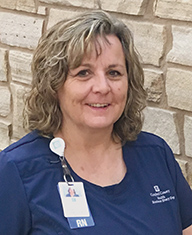Next spring construction will begin on a $28 million project to completely
replace every inpatient room in
Campbell County Memorial Hospital. With the help of experts from
HGA Architects and Engineers, the project has been in the works for over 1.5 years.
Why is it taking so long? Before drawing any floorplans or finalizing the
design, we asked the people who do the actual work of patient care; nurses,
nursing aides, environmental services and dietary staff to create their
ideal vision of what a patient room should be.
Members of the Patient and Family Advisory Council PFAC) looked at the
project from the patient and family’s point of view, and the team
visited other hospitals in the state and across the country to see the
best practices in patient room design.
The group used a process called Lean to analyze the current rooms and the
workflow. In the simplest terms, Lean thinking looks at how waste can
be eliminated to create value. Waste can be defined in many ways, such
as the time it takes a nurse to respond to a patient’s call light,
or the distance a family must travel to find a space to gather near the
patient’s room.
Facilitated by CCH Process Improvement Coordinator Bud Lawrence, data was
collected on every aspect of a patient’s experience in their hospital
room, down to how many steps a nurse walks each shift to care for their
patients. All the data, ideas from the team, ideas from other facilities
and the expertise of the architects were brought together to create a
larger, more comfortable and efficient room design for
medical surgical,
ICU and
OB patients. The space above the hospital lobby and the current Maternal Child unit
will be turned into 39 patient rooms—basically two new patient rooms
for every three existing rooms, along with new waiting rooms and gathering
spaces for patients and families.
Financial projections show the project can be funded with existing cash
and revenue, though other options are being discussed, such as bond financing.
No final decisions have been made yet. The project will take at least
20 months to complete after construction starts, and the
Board of Trustees must still decide if the project should be built in two years, or stretch
out to four years.
The problems
- Current rooms are too small to accommodate modern equipment and family
members who want to visit or spend the night
- Bathrooms are too small and don't have a sink inside the bathroom
- Maternal child rooms didn’t really work for how babies are delivered
and cared for now—mom stays in the same room through her entire say
- The location of supplies and nursing stations are inefficient and prevents
nurses from spending more time at the bedside
Helping Patients Heal
 “Having family around is part of how patients heal. Right now there
just isn’t room for the family to be in one of our current rooms—they
feel they’re in the way of the nurses or they can’t stay overnight
comfortably.”
“Having family around is part of how patients heal. Right now there
just isn’t room for the family to be in one of our current rooms—they
feel they’re in the way of the nurses or they can’t stay overnight
comfortably.”
Sherry Bailey is the Director of the ICU and one of the 30-plus team members
that have been involved in the design of the new patient rooms. A nurse
for 25 years, her focus is on the health and safety of both the patient
and the nurses she supervises.
“I was surprised and proud to be asked my opinion about the design
and function of the rooms,” said Sherry. “We were all given
the freedom to say how we could do our work better, and we were listened
to. This isn’t about a cool paint color on the walls—it’s
about how we can get a better design for more safe and efficient care—to
spend more time with the patient.”
Learn more about the project at
www.cchwyo.org/ptrooms.
Image shows an architech's rendering of a new medical/surgical patient room